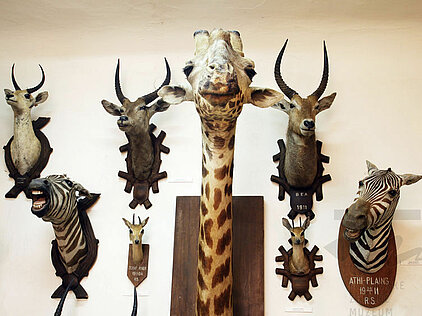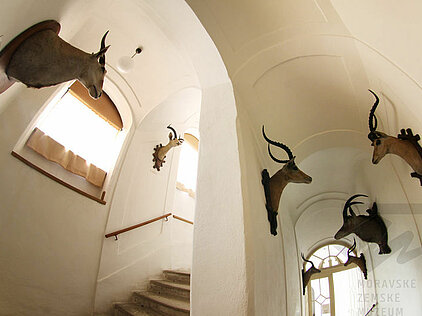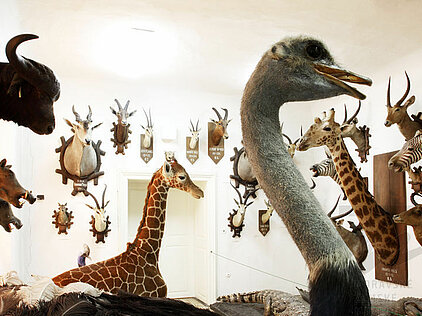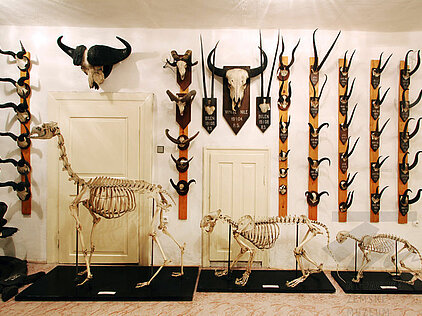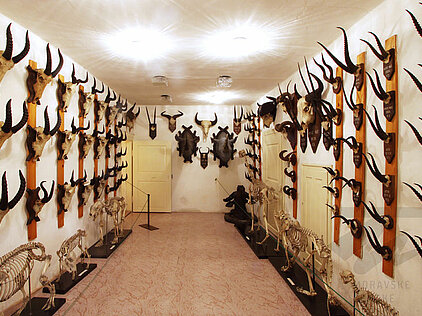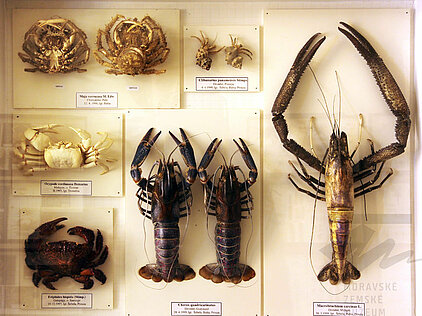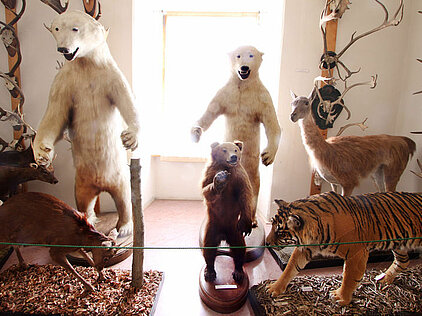Zoological storeroom open to the public - Budišov
The zoological collection kept in the castle storeroom belongs to the oldest holdings of the Moravian Museum. It has been assembled since the middle of the 19th century and contains besides the majority of vertebrates living on the territory of our state before all exotic species from all over the world.
Besides more than 700 trophies of ungulates from hunting expeditions to Africa, America and Asia (giraffe, antelope, gazelle, buffalo, wildebeest, zebra, elk, reindeer) there are round 3000 exotic birds including common ostrich, emu, hornbill, toucan, ibis, hummingbird, parrot, and kingfisher. Water birds are also strongly represented: stork, heron, goose, duck, tern, gull, as well as inhabitants of could regions (auk, guillemot, skua), penguins adapted to the life in water and sea and littoral birds (albatross, fulmar, brigadebird, flamingo, gannet). Of course, the visitors can see majestic birds of prey (eagle, vulture, condor), owls, cuckoos or representatives of woodpeckers (woodpecker, spotted woodpecker, oriole).
Guided tour:
Guided tour through zoological collections held in the castle storeroom, accumulated gradually since the middle of the 19th century and containing besides the majority of vertebrates living on the territory of our state before all exotic species from all over the world.
In the permanent exhibition we emphasize the top exhibits of big beasts of prey (lion, tiger, cheetah, brown bear and ice bear). There are also representatives of all known species of even-toed ungulates (roebuck, fallow deer, bezoar goat, wild boar) and local small mammals (fox, badger, marten, polecat, weasel, hedgehog, mole). Interest of the visitors focuses on the attractive platypus, echidna or opossum as well as on representatives of primates (orang-utan, chimpanzee, muriqui, guereza) including prosimians (slender loris, slow loris). A nearly complete collection of local fishes is prepared for fishermen.
Other groups of vertebrates are represented e.g. with sharks (besides others there is the very rare nose shark from the depth of the Japanese sea), ray, lungfish, flatfish, swordfish, from amphibians there are cane toad, Surinam horned frog from Amazonia, phyllomedusa iheringi or American bullfrog, the biggest frog from Northern America bred in farms for its legs. Reptiles are represented with several turtle species including Hawksbill turtle and Pinta Island tortoise, alligator, crocodiles, iguanas and monitors, from snakes e.g. boa, cobra, coral snake and rattlesnake.
Other rooms of the castle store are dedicated to the collection of skeletons and skulls and a collection of more than 150 species of cancers and crabs. Besides the famous marine hermit crabs, fiddler crabs and other smaller species there are also the biggest ones - lobster, langouste and Japanese spider crab living in 50-400 m depth and having the span of forelimbs with claws 4-5 m in males.
The collection is complemented with examples of other invertebrates - sea sponges, cnidarians (dead man's fingers, sea pen, polyp, medusas, corals) and worms (taenia, roundworm, thorny-headed worm). The rich collection of sea mollusc shells is complemented with examples of echinoderms (starfishes, sea urchins, sea cucumbers) and the most primitive representatives of chordates (sea squirts, salps). From crustaceans there are e. g. fairy shrimp, longtail tadpole shrimp, seed shrimp, and barnacle, from arthropods arachnids, centipedes and millipedes.
